Critical Evaluation of Carrier Obligations in Sea Transport Contracts
VerifiedAdded on 2022/03/24
|8
|2231
|30
Essay
AI Summary
This essay provides a critical evaluation of the obligations of carriers arising from contracts for the carriage of goods by sea, examining both common law principles and relevant international agreements. It begins by outlining the roles and responsibilities of shippers and carriers, emphasizing the importance of sea transport in global trade. The essay then delves into key international laws and agreements, including the Hague Rules, Hague-Visby Rules, Hamburg Rules, and the Rotterdam Rules, analyzing their impact on carrier obligations, liability limitations, and the allocation of risks. It explores the evolution of these regulations, highlighting the shift from port-to-port responsibility to broader coverage. The discussion includes the complexities of misrepresentation in bills of lading and the impact of carrier obligations on the international maritime industry. The essay concludes by summarizing the key findings and emphasizing the ongoing relevance of these legal frameworks in the context of modern shipping practices and global trade. The essay underscores the importance of balancing the interests of both carriers and cargo owners to ensure fairness and efficiency in international maritime transport.
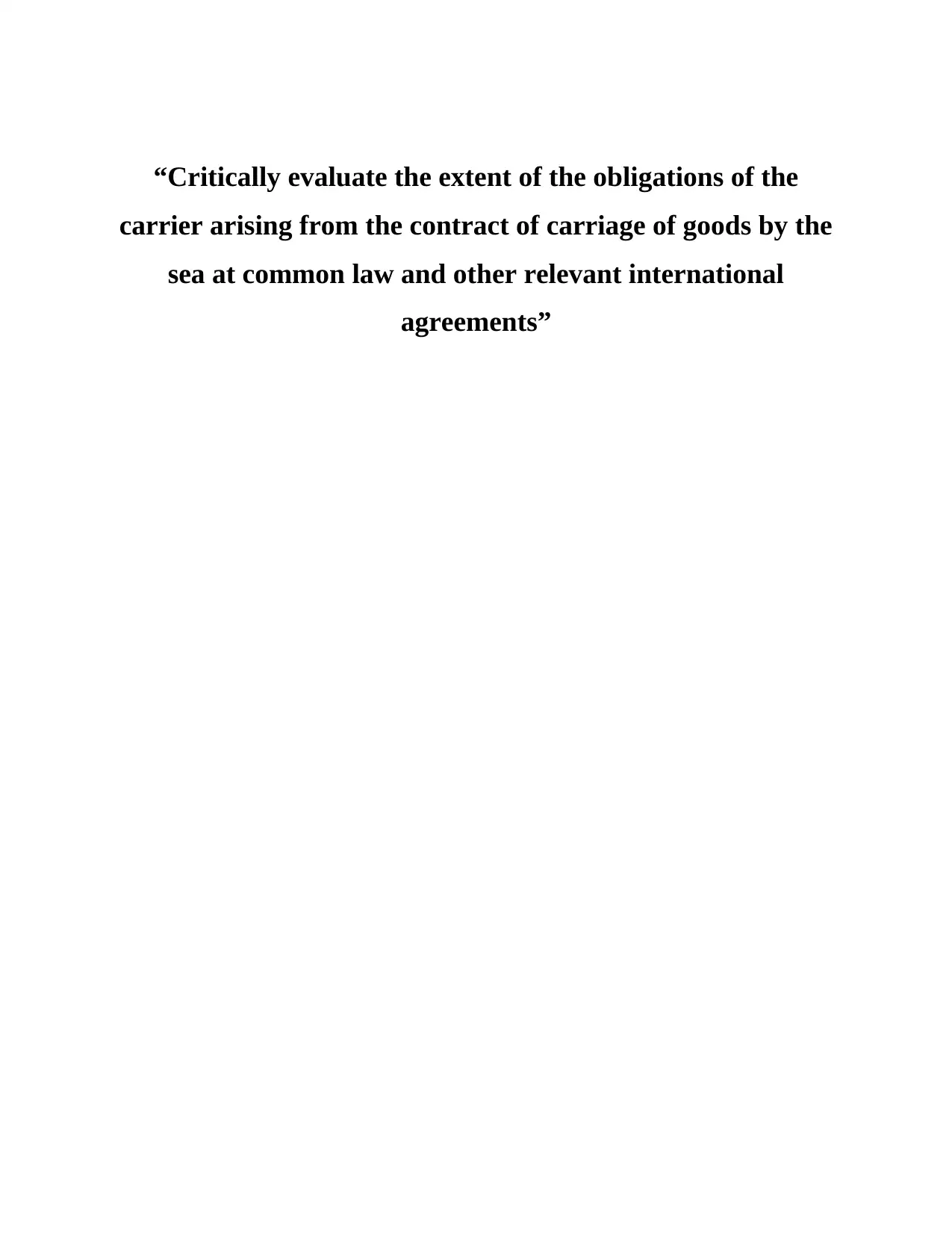
“Critically evaluate the extent of the obligations of the
carrier arising from the contract of carriage of goods by the
sea at common law and other relevant international
agreements”
carrier arising from the contract of carriage of goods by the
sea at common law and other relevant international
agreements”
Paraphrase This Document
Need a fresh take? Get an instant paraphrase of this document with our AI Paraphraser
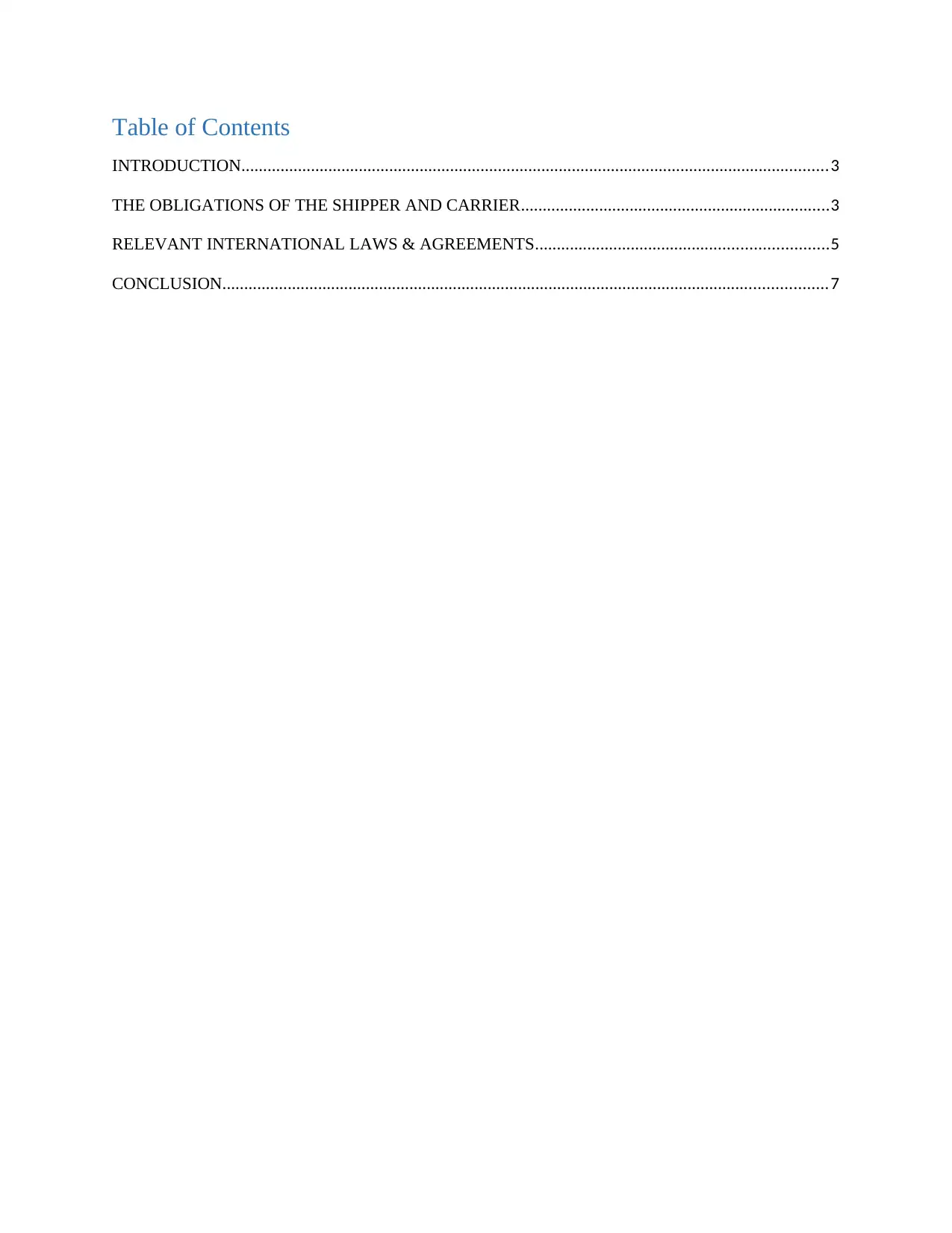
Table of Contents
INTRODUCTION.......................................................................................................................................3
THE OBLIGATIONS OF THE SHIPPER AND CARRIER.......................................................................3
RELEVANT INTERNATIONAL LAWS & AGREEMENTS...................................................................5
CONCLUSION...........................................................................................................................................7
INTRODUCTION.......................................................................................................................................3
THE OBLIGATIONS OF THE SHIPPER AND CARRIER.......................................................................3
RELEVANT INTERNATIONAL LAWS & AGREEMENTS...................................................................5
CONCLUSION...........................................................................................................................................7
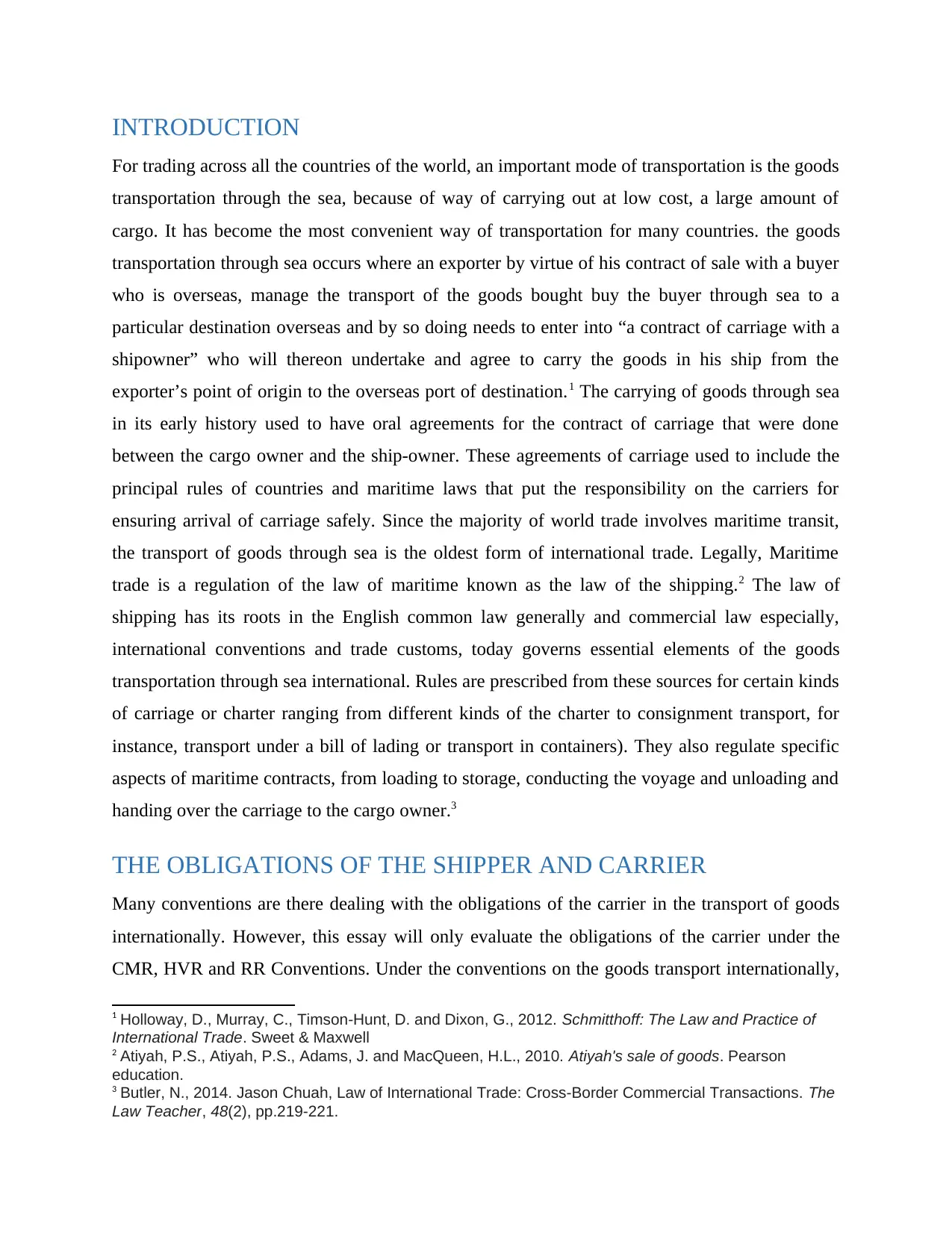
INTRODUCTION
For trading across all the countries of the world, an important mode of transportation is the goods
transportation through the sea, because of way of carrying out at low cost, a large amount of
cargo. It has become the most convenient way of transportation for many countries. the goods
transportation through sea occurs where an exporter by virtue of his contract of sale with a buyer
who is overseas, manage the transport of the goods bought buy the buyer through sea to a
particular destination overseas and by so doing needs to enter into “a contract of carriage with a
shipowner” who will thereon undertake and agree to carry the goods in his ship from the
exporter’s point of origin to the overseas port of destination.1 The carrying of goods through sea
in its early history used to have oral agreements for the contract of carriage that were done
between the cargo owner and the ship-owner. These agreements of carriage used to include the
principal rules of countries and maritime laws that put the responsibility on the carriers for
ensuring arrival of carriage safely. Since the majority of world trade involves maritime transit,
the transport of goods through sea is the oldest form of international trade. Legally, Maritime
trade is a regulation of the law of maritime known as the law of the shipping.2 The law of
shipping has its roots in the English common law generally and commercial law especially,
international conventions and trade customs, today governs essential elements of the goods
transportation through sea international. Rules are prescribed from these sources for certain kinds
of carriage or charter ranging from different kinds of the charter to consignment transport, for
instance, transport under a bill of lading or transport in containers). They also regulate specific
aspects of maritime contracts, from loading to storage, conducting the voyage and unloading and
handing over the carriage to the cargo owner.3
THE OBLIGATIONS OF THE SHIPPER AND CARRIER
Many conventions are there dealing with the obligations of the carrier in the transport of goods
internationally. However, this essay will only evaluate the obligations of the carrier under the
CMR, HVR and RR Conventions. Under the conventions on the goods transport internationally,
1 Holloway, D., Murray, C., Timson-Hunt, D. and Dixon, G., 2012. Schmitthoff: The Law and Practice of
International Trade. Sweet & Maxwell
2 Atiyah, P.S., Atiyah, P.S., Adams, J. and MacQueen, H.L., 2010. Atiyah's sale of goods. Pearson
education.
3 Butler, N., 2014. Jason Chuah, Law of International Trade: Cross-Border Commercial Transactions. The
Law Teacher, 48(2), pp.219-221.
For trading across all the countries of the world, an important mode of transportation is the goods
transportation through the sea, because of way of carrying out at low cost, a large amount of
cargo. It has become the most convenient way of transportation for many countries. the goods
transportation through sea occurs where an exporter by virtue of his contract of sale with a buyer
who is overseas, manage the transport of the goods bought buy the buyer through sea to a
particular destination overseas and by so doing needs to enter into “a contract of carriage with a
shipowner” who will thereon undertake and agree to carry the goods in his ship from the
exporter’s point of origin to the overseas port of destination.1 The carrying of goods through sea
in its early history used to have oral agreements for the contract of carriage that were done
between the cargo owner and the ship-owner. These agreements of carriage used to include the
principal rules of countries and maritime laws that put the responsibility on the carriers for
ensuring arrival of carriage safely. Since the majority of world trade involves maritime transit,
the transport of goods through sea is the oldest form of international trade. Legally, Maritime
trade is a regulation of the law of maritime known as the law of the shipping.2 The law of
shipping has its roots in the English common law generally and commercial law especially,
international conventions and trade customs, today governs essential elements of the goods
transportation through sea international. Rules are prescribed from these sources for certain kinds
of carriage or charter ranging from different kinds of the charter to consignment transport, for
instance, transport under a bill of lading or transport in containers). They also regulate specific
aspects of maritime contracts, from loading to storage, conducting the voyage and unloading and
handing over the carriage to the cargo owner.3
THE OBLIGATIONS OF THE SHIPPER AND CARRIER
Many conventions are there dealing with the obligations of the carrier in the transport of goods
internationally. However, this essay will only evaluate the obligations of the carrier under the
CMR, HVR and RR Conventions. Under the conventions on the goods transport internationally,
1 Holloway, D., Murray, C., Timson-Hunt, D. and Dixon, G., 2012. Schmitthoff: The Law and Practice of
International Trade. Sweet & Maxwell
2 Atiyah, P.S., Atiyah, P.S., Adams, J. and MacQueen, H.L., 2010. Atiyah's sale of goods. Pearson
education.
3 Butler, N., 2014. Jason Chuah, Law of International Trade: Cross-Border Commercial Transactions. The
Law Teacher, 48(2), pp.219-221.
⊘ This is a preview!⊘
Do you want full access?
Subscribe today to unlock all pages.

Trusted by 1+ million students worldwide
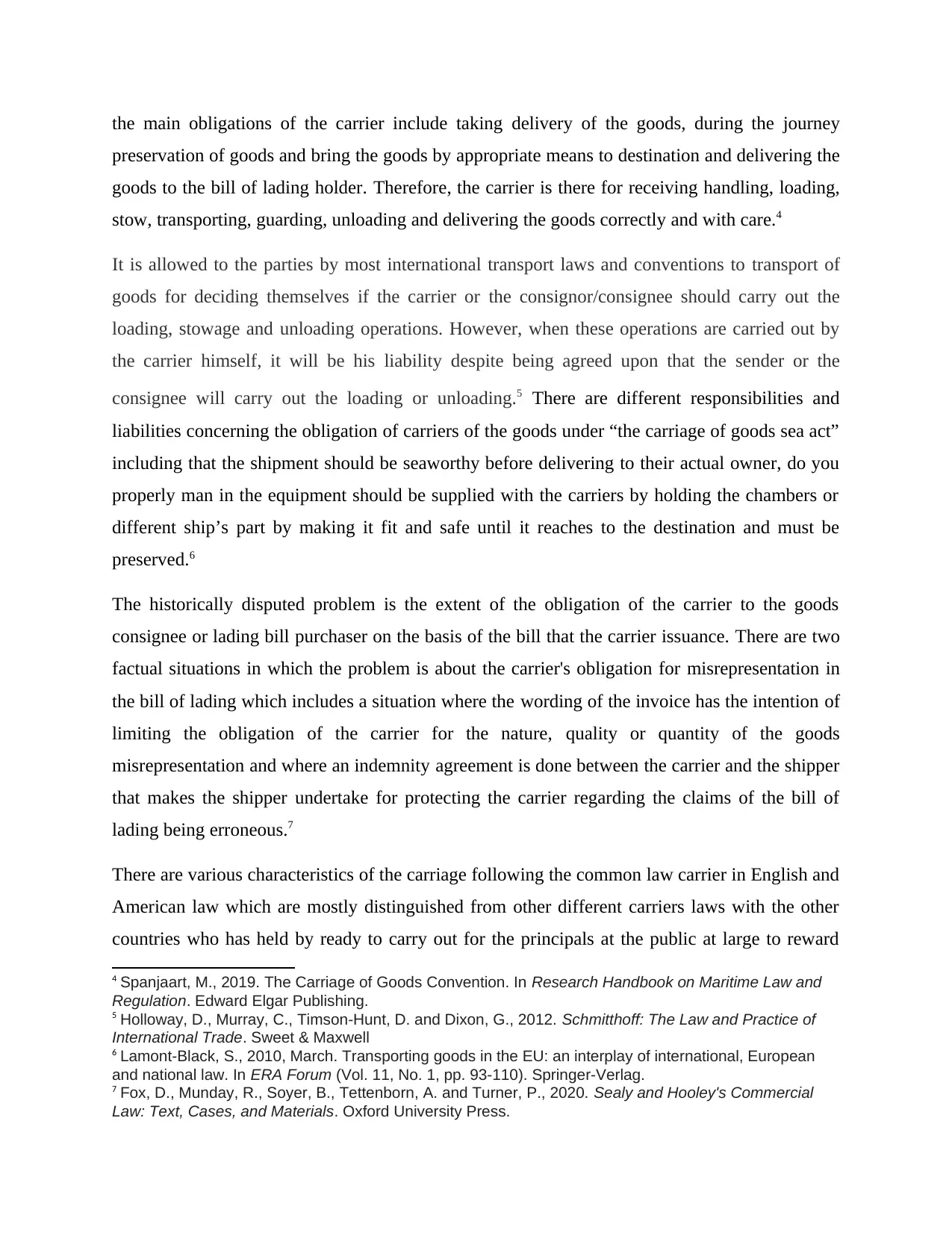
the main obligations of the carrier include taking delivery of the goods, during the journey
preservation of goods and bring the goods by appropriate means to destination and delivering the
goods to the bill of lading holder. Therefore, the carrier is there for receiving handling, loading,
stow, transporting, guarding, unloading and delivering the goods correctly and with care.4
It is allowed to the parties by most international transport laws and conventions to transport of
goods for deciding themselves if the carrier or the consignor/consignee should carry out the
loading, stowage and unloading operations. However, when these operations are carried out by
the carrier himself, it will be his liability despite being agreed upon that the sender or the
consignee will carry out the loading or unloading.5 There are different responsibilities and
liabilities concerning the obligation of carriers of the goods under “the carriage of goods sea act”
including that the shipment should be seaworthy before delivering to their actual owner, do you
properly man in the equipment should be supplied with the carriers by holding the chambers or
different ship’s part by making it fit and safe until it reaches to the destination and must be
preserved.6
The historically disputed problem is the extent of the obligation of the carrier to the goods
consignee or lading bill purchaser on the basis of the bill that the carrier issuance. There are two
factual situations in which the problem is about the carrier's obligation for misrepresentation in
the bill of lading which includes a situation where the wording of the invoice has the intention of
limiting the obligation of the carrier for the nature, quality or quantity of the goods
misrepresentation and where an indemnity agreement is done between the carrier and the shipper
that makes the shipper undertake for protecting the carrier regarding the claims of the bill of
lading being erroneous.7
There are various characteristics of the carriage following the common law carrier in English and
American law which are mostly distinguished from other different carriers laws with the other
countries who has held by ready to carry out for the principals at the public at large to reward
4 Spanjaart, M., 2019. The Carriage of Goods Convention. In Research Handbook on Maritime Law and
Regulation. Edward Elgar Publishing.
5 Holloway, D., Murray, C., Timson-Hunt, D. and Dixon, G., 2012. Schmitthoff: The Law and Practice of
International Trade. Sweet & Maxwell
6 Lamont-Black, S., 2010, March. Transporting goods in the EU: an interplay of international, European
and national law. In ERA Forum (Vol. 11, No. 1, pp. 93-110). Springer-Verlag.
7 Fox, D., Munday, R., Soyer, B., Tettenborn, A. and Turner, P., 2020. Sealy and Hooley's Commercial
Law: Text, Cases, and Materials. Oxford University Press.
preservation of goods and bring the goods by appropriate means to destination and delivering the
goods to the bill of lading holder. Therefore, the carrier is there for receiving handling, loading,
stow, transporting, guarding, unloading and delivering the goods correctly and with care.4
It is allowed to the parties by most international transport laws and conventions to transport of
goods for deciding themselves if the carrier or the consignor/consignee should carry out the
loading, stowage and unloading operations. However, when these operations are carried out by
the carrier himself, it will be his liability despite being agreed upon that the sender or the
consignee will carry out the loading or unloading.5 There are different responsibilities and
liabilities concerning the obligation of carriers of the goods under “the carriage of goods sea act”
including that the shipment should be seaworthy before delivering to their actual owner, do you
properly man in the equipment should be supplied with the carriers by holding the chambers or
different ship’s part by making it fit and safe until it reaches to the destination and must be
preserved.6
The historically disputed problem is the extent of the obligation of the carrier to the goods
consignee or lading bill purchaser on the basis of the bill that the carrier issuance. There are two
factual situations in which the problem is about the carrier's obligation for misrepresentation in
the bill of lading which includes a situation where the wording of the invoice has the intention of
limiting the obligation of the carrier for the nature, quality or quantity of the goods
misrepresentation and where an indemnity agreement is done between the carrier and the shipper
that makes the shipper undertake for protecting the carrier regarding the claims of the bill of
lading being erroneous.7
There are various characteristics of the carriage following the common law carrier in English and
American law which are mostly distinguished from other different carriers laws with the other
countries who has held by ready to carry out for the principals at the public at large to reward
4 Spanjaart, M., 2019. The Carriage of Goods Convention. In Research Handbook on Maritime Law and
Regulation. Edward Elgar Publishing.
5 Holloway, D., Murray, C., Timson-Hunt, D. and Dixon, G., 2012. Schmitthoff: The Law and Practice of
International Trade. Sweet & Maxwell
6 Lamont-Black, S., 2010, March. Transporting goods in the EU: an interplay of international, European
and national law. In ERA Forum (Vol. 11, No. 1, pp. 93-110). Springer-Verlag.
7 Fox, D., Munday, R., Soyer, B., Tettenborn, A. and Turner, P., 2020. Sealy and Hooley's Commercial
Law: Text, Cases, and Materials. Oxford University Press.
Paraphrase This Document
Need a fresh take? Get an instant paraphrase of this document with our AI Paraphraser
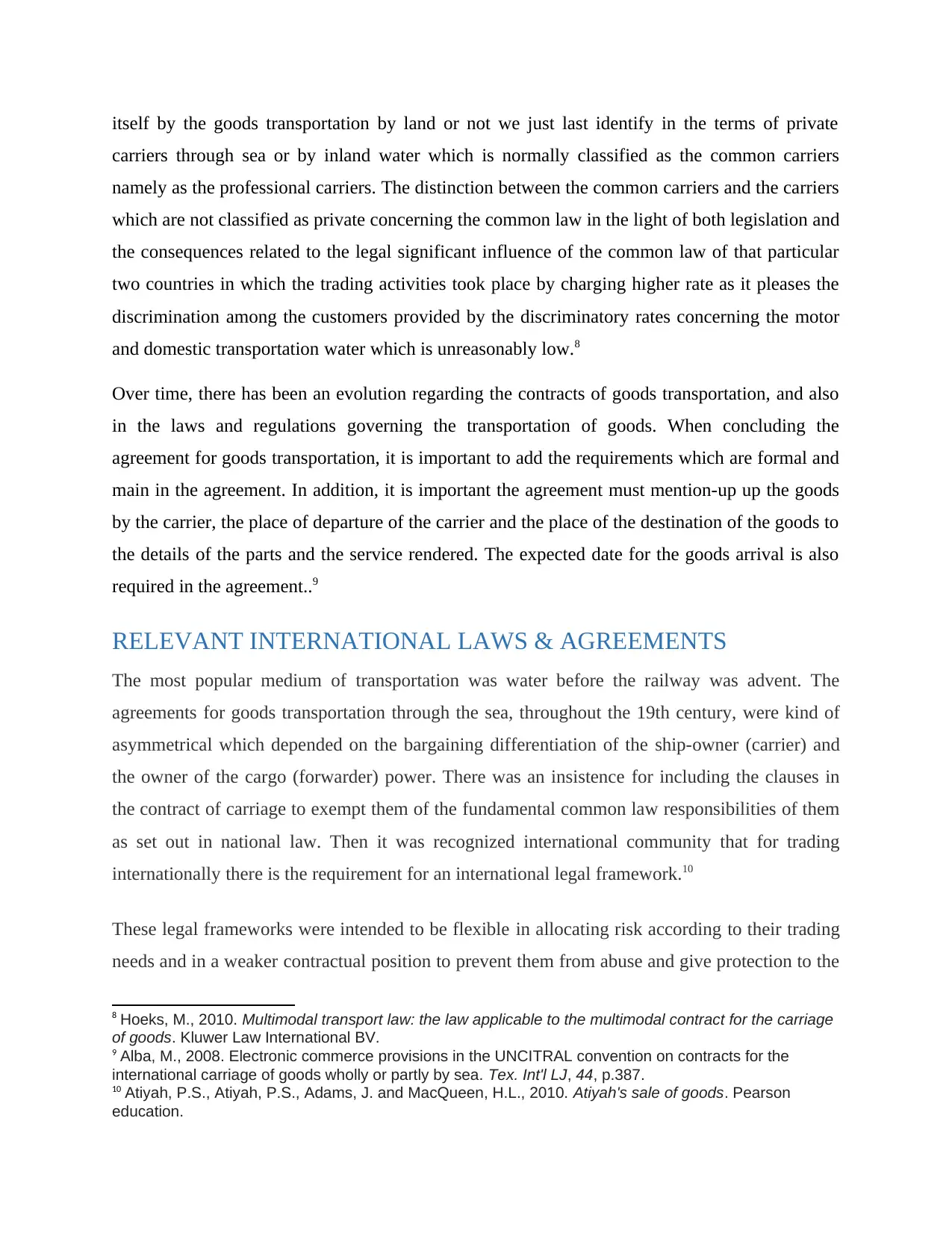
itself by the goods transportation by land or not we just last identify in the terms of private
carriers through sea or by inland water which is normally classified as the common carriers
namely as the professional carriers. The distinction between the common carriers and the carriers
which are not classified as private concerning the common law in the light of both legislation and
the consequences related to the legal significant influence of the common law of that particular
two countries in which the trading activities took place by charging higher rate as it pleases the
discrimination among the customers provided by the discriminatory rates concerning the motor
and domestic transportation water which is unreasonably low.8
Over time, there has been an evolution regarding the contracts of goods transportation, and also
in the laws and regulations governing the transportation of goods. When concluding the
agreement for goods transportation, it is important to add the requirements which are formal and
main in the agreement. In addition, it is important the agreement must mention-up up the goods
by the carrier, the place of departure of the carrier and the place of the destination of the goods to
the details of the parts and the service rendered. The expected date for the goods arrival is also
required in the agreement..9
RELEVANT INTERNATIONAL LAWS & AGREEMENTS
The most popular medium of transportation was water before the railway was advent. The
agreements for goods transportation through the sea, throughout the 19th century, were kind of
asymmetrical which depended on the bargaining differentiation of the ship-owner (carrier) and
the owner of the cargo (forwarder) power. There was an insistence for including the clauses in
the contract of carriage to exempt them of the fundamental common law responsibilities of them
as set out in national law. Then it was recognized international community that for trading
internationally there is the requirement for an international legal framework.10
These legal frameworks were intended to be flexible in allocating risk according to their trading
needs and in a weaker contractual position to prevent them from abuse and give protection to the
8 Hoeks, M., 2010. Multimodal transport law: the law applicable to the multimodal contract for the carriage
of goods. Kluwer Law International BV.
9 Alba, M., 2008. Electronic commerce provisions in the UNCITRAL convention on contracts for the
international carriage of goods wholly or partly by sea. Tex. Int'l LJ, 44, p.387.
10 Atiyah, P.S., Atiyah, P.S., Adams, J. and MacQueen, H.L., 2010. Atiyah's sale of goods. Pearson
education.
carriers through sea or by inland water which is normally classified as the common carriers
namely as the professional carriers. The distinction between the common carriers and the carriers
which are not classified as private concerning the common law in the light of both legislation and
the consequences related to the legal significant influence of the common law of that particular
two countries in which the trading activities took place by charging higher rate as it pleases the
discrimination among the customers provided by the discriminatory rates concerning the motor
and domestic transportation water which is unreasonably low.8
Over time, there has been an evolution regarding the contracts of goods transportation, and also
in the laws and regulations governing the transportation of goods. When concluding the
agreement for goods transportation, it is important to add the requirements which are formal and
main in the agreement. In addition, it is important the agreement must mention-up up the goods
by the carrier, the place of departure of the carrier and the place of the destination of the goods to
the details of the parts and the service rendered. The expected date for the goods arrival is also
required in the agreement..9
RELEVANT INTERNATIONAL LAWS & AGREEMENTS
The most popular medium of transportation was water before the railway was advent. The
agreements for goods transportation through the sea, throughout the 19th century, were kind of
asymmetrical which depended on the bargaining differentiation of the ship-owner (carrier) and
the owner of the cargo (forwarder) power. There was an insistence for including the clauses in
the contract of carriage to exempt them of the fundamental common law responsibilities of them
as set out in national law. Then it was recognized international community that for trading
internationally there is the requirement for an international legal framework.10
These legal frameworks were intended to be flexible in allocating risk according to their trading
needs and in a weaker contractual position to prevent them from abuse and give protection to the
8 Hoeks, M., 2010. Multimodal transport law: the law applicable to the multimodal contract for the carriage
of goods. Kluwer Law International BV.
9 Alba, M., 2008. Electronic commerce provisions in the UNCITRAL convention on contracts for the
international carriage of goods wholly or partly by sea. Tex. Int'l LJ, 44, p.387.
10 Atiyah, P.S., Atiyah, P.S., Adams, J. and MacQueen, H.L., 2010. Atiyah's sale of goods. Pearson
education.
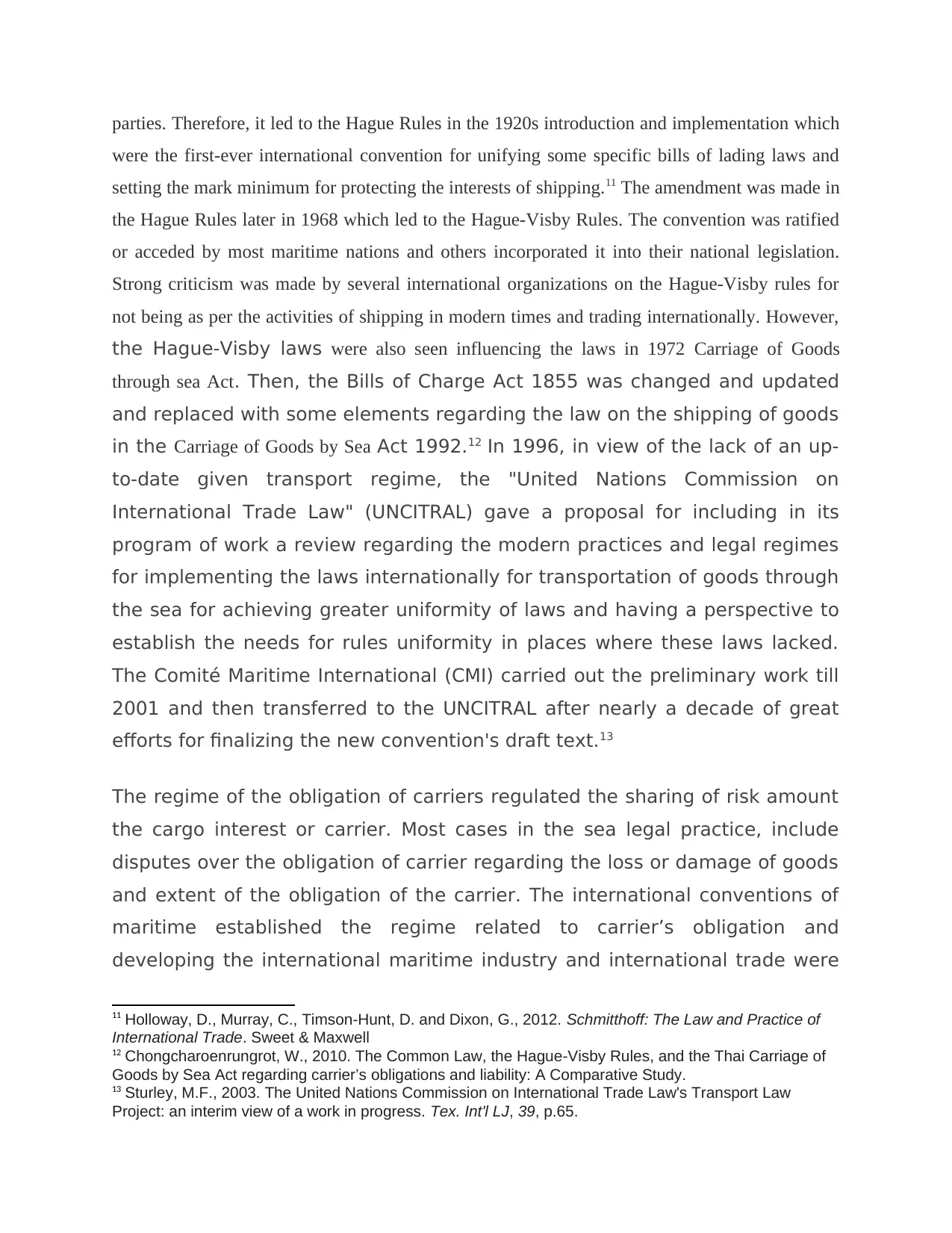
parties. Therefore, it led to the Hague Rules in the 1920s introduction and implementation which
were the first-ever international convention for unifying some specific bills of lading laws and
setting the mark minimum for protecting the interests of shipping.11 The amendment was made in
the Hague Rules later in 1968 which led to the Hague-Visby Rules. The convention was ratified
or acceded by most maritime nations and others incorporated it into their national legislation.
Strong criticism was made by several international organizations on the Hague-Visby rules for
not being as per the activities of shipping in modern times and trading internationally. However,
the Hague-Visby laws were also seen influencing the laws in 1972 Carriage of Goods
through sea Act. Then, the Bills of Charge Act 1855 was changed and updated
and replaced with some elements regarding the law on the shipping of goods
in the Carriage of Goods by Sea Act 1992.12 In 1996, in view of the lack of an up-
to-date given transport regime, the "United Nations Commission on
International Trade Law" (UNCITRAL) gave a proposal for including in its
program of work a review regarding the modern practices and legal regimes
for implementing the laws internationally for transportation of goods through
the sea for achieving greater uniformity of laws and having a perspective to
establish the needs for rules uniformity in places where these laws lacked.
The Comité Maritime International (CMI) carried out the preliminary work till
2001 and then transferred to the UNCITRAL after nearly a decade of great
efforts for finalizing the new convention's draft text.13
The regime of the obligation of carriers regulated the sharing of risk amount
the cargo interest or carrier. Most cases in the sea legal practice, include
disputes over the obligation of carrier regarding the loss or damage of goods
and extent of the obligation of the carrier. The international conventions of
maritime established the regime related to carrier’s obligation and
developing the international maritime industry and international trade were
11 Holloway, D., Murray, C., Timson-Hunt, D. and Dixon, G., 2012. Schmitthoff: The Law and Practice of
International Trade. Sweet & Maxwell
12 Chongcharoenrungrot, W., 2010. The Common Law, the Hague-Visby Rules, and the Thai Carriage of
Goods by Sea Act regarding carrier’s obligations and liability: A Comparative Study.
13 Sturley, M.F., 2003. The United Nations Commission on International Trade Law's Transport Law
Project: an interim view of a work in progress. Tex. Int'l LJ, 39, p.65.
were the first-ever international convention for unifying some specific bills of lading laws and
setting the mark minimum for protecting the interests of shipping.11 The amendment was made in
the Hague Rules later in 1968 which led to the Hague-Visby Rules. The convention was ratified
or acceded by most maritime nations and others incorporated it into their national legislation.
Strong criticism was made by several international organizations on the Hague-Visby rules for
not being as per the activities of shipping in modern times and trading internationally. However,
the Hague-Visby laws were also seen influencing the laws in 1972 Carriage of Goods
through sea Act. Then, the Bills of Charge Act 1855 was changed and updated
and replaced with some elements regarding the law on the shipping of goods
in the Carriage of Goods by Sea Act 1992.12 In 1996, in view of the lack of an up-
to-date given transport regime, the "United Nations Commission on
International Trade Law" (UNCITRAL) gave a proposal for including in its
program of work a review regarding the modern practices and legal regimes
for implementing the laws internationally for transportation of goods through
the sea for achieving greater uniformity of laws and having a perspective to
establish the needs for rules uniformity in places where these laws lacked.
The Comité Maritime International (CMI) carried out the preliminary work till
2001 and then transferred to the UNCITRAL after nearly a decade of great
efforts for finalizing the new convention's draft text.13
The regime of the obligation of carriers regulated the sharing of risk amount
the cargo interest or carrier. Most cases in the sea legal practice, include
disputes over the obligation of carrier regarding the loss or damage of goods
and extent of the obligation of the carrier. The international conventions of
maritime established the regime related to carrier’s obligation and
developing the international maritime industry and international trade were
11 Holloway, D., Murray, C., Timson-Hunt, D. and Dixon, G., 2012. Schmitthoff: The Law and Practice of
International Trade. Sweet & Maxwell
12 Chongcharoenrungrot, W., 2010. The Common Law, the Hague-Visby Rules, and the Thai Carriage of
Goods by Sea Act regarding carrier’s obligations and liability: A Comparative Study.
13 Sturley, M.F., 2003. The United Nations Commission on International Trade Law's Transport Law
Project: an interim view of a work in progress. Tex. Int'l LJ, 39, p.65.
⊘ This is a preview!⊘
Do you want full access?
Subscribe today to unlock all pages.

Trusted by 1+ million students worldwide
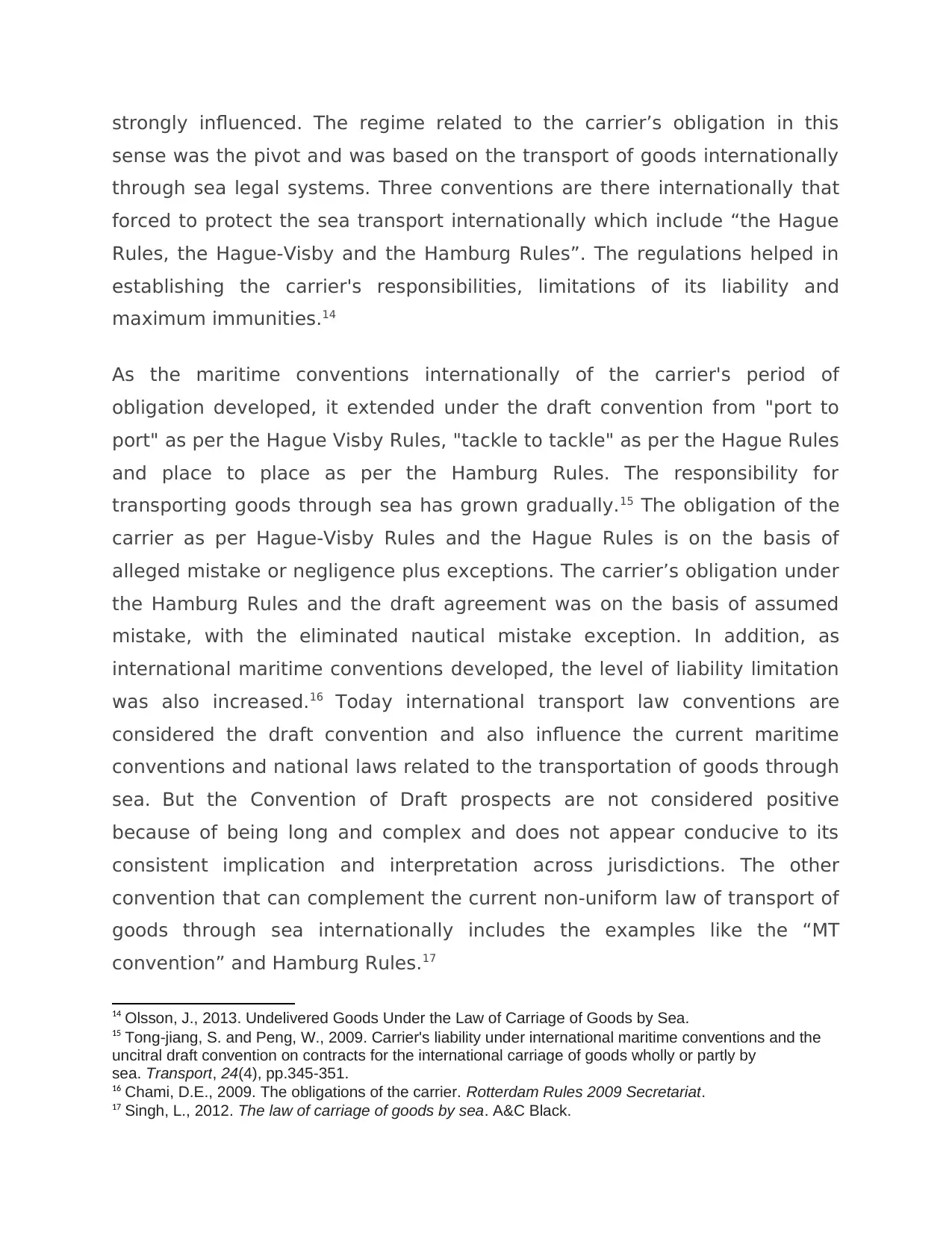
strongly influenced. The regime related to the carrier’s obligation in this
sense was the pivot and was based on the transport of goods internationally
through sea legal systems. Three conventions are there internationally that
forced to protect the sea transport internationally which include “the Hague
Rules, the Hague-Visby and the Hamburg Rules”. The regulations helped in
establishing the carrier's responsibilities, limitations of its liability and
maximum immunities.14
As the maritime conventions internationally of the carrier's period of
obligation developed, it extended under the draft convention from "port to
port" as per the Hague Visby Rules, "tackle to tackle" as per the Hague Rules
and place to place as per the Hamburg Rules. The responsibility for
transporting goods through sea has grown gradually.15 The obligation of the
carrier as per Hague-Visby Rules and the Hague Rules is on the basis of
alleged mistake or negligence plus exceptions. The carrier’s obligation under
the Hamburg Rules and the draft agreement was on the basis of assumed
mistake, with the eliminated nautical mistake exception. In addition, as
international maritime conventions developed, the level of liability limitation
was also increased.16 Today international transport law conventions are
considered the draft convention and also influence the current maritime
conventions and national laws related to the transportation of goods through
sea. But the Convention of Draft prospects are not considered positive
because of being long and complex and does not appear conducive to its
consistent implication and interpretation across jurisdictions. The other
convention that can complement the current non-uniform law of transport of
goods through sea internationally includes the examples like the “MT
convention” and Hamburg Rules.17
14 Olsson, J., 2013. Undelivered Goods Under the Law of Carriage of Goods by Sea.
15 Tong‐jiang, S. and Peng, W., 2009. Carrier's liability under international maritime conventions and the
uncitral draft convention on contracts for the international carriage of goods wholly or partly by
sea. Transport, 24(4), pp.345-351.
16 Chami, D.E., 2009. The obligations of the carrier. Rotterdam Rules 2009 Secretariat.
17 Singh, L., 2012. The law of carriage of goods by sea. A&C Black.
sense was the pivot and was based on the transport of goods internationally
through sea legal systems. Three conventions are there internationally that
forced to protect the sea transport internationally which include “the Hague
Rules, the Hague-Visby and the Hamburg Rules”. The regulations helped in
establishing the carrier's responsibilities, limitations of its liability and
maximum immunities.14
As the maritime conventions internationally of the carrier's period of
obligation developed, it extended under the draft convention from "port to
port" as per the Hague Visby Rules, "tackle to tackle" as per the Hague Rules
and place to place as per the Hamburg Rules. The responsibility for
transporting goods through sea has grown gradually.15 The obligation of the
carrier as per Hague-Visby Rules and the Hague Rules is on the basis of
alleged mistake or negligence plus exceptions. The carrier’s obligation under
the Hamburg Rules and the draft agreement was on the basis of assumed
mistake, with the eliminated nautical mistake exception. In addition, as
international maritime conventions developed, the level of liability limitation
was also increased.16 Today international transport law conventions are
considered the draft convention and also influence the current maritime
conventions and national laws related to the transportation of goods through
sea. But the Convention of Draft prospects are not considered positive
because of being long and complex and does not appear conducive to its
consistent implication and interpretation across jurisdictions. The other
convention that can complement the current non-uniform law of transport of
goods through sea internationally includes the examples like the “MT
convention” and Hamburg Rules.17
14 Olsson, J., 2013. Undelivered Goods Under the Law of Carriage of Goods by Sea.
15 Tong‐jiang, S. and Peng, W., 2009. Carrier's liability under international maritime conventions and the
uncitral draft convention on contracts for the international carriage of goods wholly or partly by
sea. Transport, 24(4), pp.345-351.
16 Chami, D.E., 2009. The obligations of the carrier. Rotterdam Rules 2009 Secretariat.
17 Singh, L., 2012. The law of carriage of goods by sea. A&C Black.
Paraphrase This Document
Need a fresh take? Get an instant paraphrase of this document with our AI Paraphraser
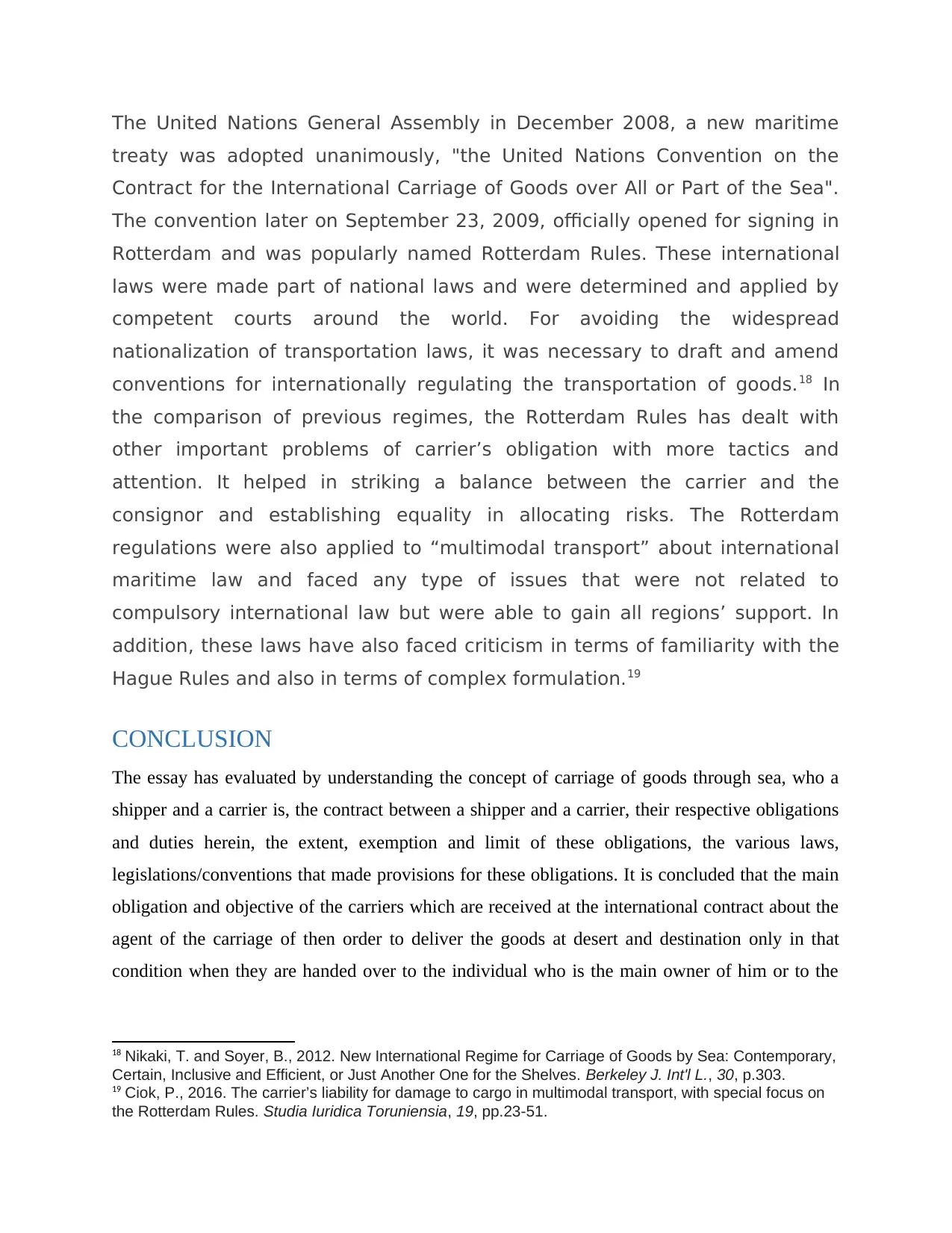
The United Nations General Assembly in December 2008, a new maritime
treaty was adopted unanimously, "the United Nations Convention on the
Contract for the International Carriage of Goods over All or Part of the Sea".
The convention later on September 23, 2009, officially opened for signing in
Rotterdam and was popularly named Rotterdam Rules. These international
laws were made part of national laws and were determined and applied by
competent courts around the world. For avoiding the widespread
nationalization of transportation laws, it was necessary to draft and amend
conventions for internationally regulating the transportation of goods.18 In
the comparison of previous regimes, the Rotterdam Rules has dealt with
other important problems of carrier’s obligation with more tactics and
attention. It helped in striking a balance between the carrier and the
consignor and establishing equality in allocating risks. The Rotterdam
regulations were also applied to “multimodal transport” about international
maritime law and faced any type of issues that were not related to
compulsory international law but were able to gain all regions’ support. In
addition, these laws have also faced criticism in terms of familiarity with the
Hague Rules and also in terms of complex formulation.19
CONCLUSION
The essay has evaluated by understanding the concept of carriage of goods through sea, who a
shipper and a carrier is, the contract between a shipper and a carrier, their respective obligations
and duties herein, the extent, exemption and limit of these obligations, the various laws,
legislations/conventions that made provisions for these obligations. It is concluded that the main
obligation and objective of the carriers which are received at the international contract about the
agent of the carriage of then order to deliver the goods at desert and destination only in that
condition when they are handed over to the individual who is the main owner of him or to the
18 Nikaki, T. and Soyer, B., 2012. New International Regime for Carriage of Goods by Sea: Contemporary,
Certain, Inclusive and Efficient, or Just Another One for the Shelves. Berkeley J. Int'l L., 30, p.303.
19 Ciok, P., 2016. The carrier’s liability for damage to cargo in multimodal transport, with special focus on
the Rotterdam Rules. Studia Iuridica Toruniensia, 19, pp.23-51.
treaty was adopted unanimously, "the United Nations Convention on the
Contract for the International Carriage of Goods over All or Part of the Sea".
The convention later on September 23, 2009, officially opened for signing in
Rotterdam and was popularly named Rotterdam Rules. These international
laws were made part of national laws and were determined and applied by
competent courts around the world. For avoiding the widespread
nationalization of transportation laws, it was necessary to draft and amend
conventions for internationally regulating the transportation of goods.18 In
the comparison of previous regimes, the Rotterdam Rules has dealt with
other important problems of carrier’s obligation with more tactics and
attention. It helped in striking a balance between the carrier and the
consignor and establishing equality in allocating risks. The Rotterdam
regulations were also applied to “multimodal transport” about international
maritime law and faced any type of issues that were not related to
compulsory international law but were able to gain all regions’ support. In
addition, these laws have also faced criticism in terms of familiarity with the
Hague Rules and also in terms of complex formulation.19
CONCLUSION
The essay has evaluated by understanding the concept of carriage of goods through sea, who a
shipper and a carrier is, the contract between a shipper and a carrier, their respective obligations
and duties herein, the extent, exemption and limit of these obligations, the various laws,
legislations/conventions that made provisions for these obligations. It is concluded that the main
obligation and objective of the carriers which are received at the international contract about the
agent of the carriage of then order to deliver the goods at desert and destination only in that
condition when they are handed over to the individual who is the main owner of him or to the
18 Nikaki, T. and Soyer, B., 2012. New International Regime for Carriage of Goods by Sea: Contemporary,
Certain, Inclusive and Efficient, or Just Another One for the Shelves. Berkeley J. Int'l L., 30, p.303.
19 Ciok, P., 2016. The carrier’s liability for damage to cargo in multimodal transport, with special focus on
the Rotterdam Rules. Studia Iuridica Toruniensia, 19, pp.23-51.
1 out of 8
Related Documents
Your All-in-One AI-Powered Toolkit for Academic Success.
+13062052269
info@desklib.com
Available 24*7 on WhatsApp / Email
![[object Object]](/_next/static/media/star-bottom.7253800d.svg)
Unlock your academic potential
Copyright © 2020–2025 A2Z Services. All Rights Reserved. Developed and managed by ZUCOL.





